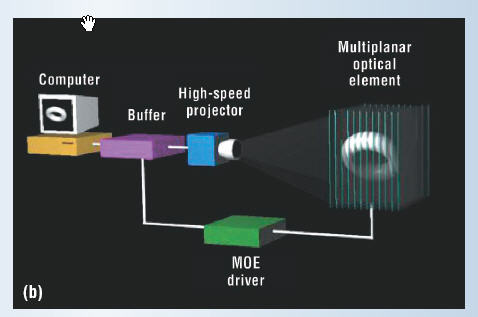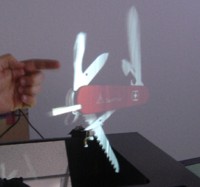But First, the foldable OLED 2D Display
Note that there is still a lot of research to be done on the eye-brain image processing machine and how it works. Here are some things we think we know:
Multiview lenticular technology allows multiple viewers wide freedom of movement without sacrificing 3D perception.
Separation between pupils for a standard person is 6.5 cm. Therefore each independent eye views a scence from a different angle and therefore generates a unique image in the brain. These slight differences between left eye and right eye images allow the brain to render "depth" in an image. In this way, a 2D display device can turn into 3D but precise image control is necessary to pull this off. Another alternative is to sue deformable mirrors. In this case, the "pixels" can be controlled to direct light to your eyes from different angles.



 in principle this gives you a more direct 3D viewing experience that
the sterographic approach because the deformable mirrors can be tuned
to match your specific eye-brain response.
in principle this gives you a more direct 3D viewing experience that
the sterographic approach because the deformable mirrors can be tuned
to match your specific eye-brain response.
Another alternative, less desireable really, is an enclosed rotating device. In the case below the actual screen is made of phosphorous elements but it rotates sufficiently fast to produce a 3D effect (but it still is a 2 D screen)
 Still another example basically consists of projecting 2D images onto a series of multiplanar optical elements (MOE) (usually a single LCD panel). A horizontal and vertical arrangement of these panels can then create a 3D image. To make this work there has to be good synchronization between the high speed projector and the orientation of the MOE. As long as this can be controlled at rates faster than your eye can process the data, the 3D effect will be perceived:

But none of these approaches are really true 3D.
A real 3D display would render an image in a real, physical, 3D volume. This is
called Volumetric 3D and each volume resolution element is known as
a voxel. So a pixel becomes a voxel.
Ultimately, all 3D volumetric displays make use of the fact that light
can scatter in 3 dimensions off the surface or particles or other
stuff. If the scattering can be controlled and focused then true
3D images can be rendered.
There are a variety of scattering mechanisms that are being tested and
we will see some examples below. The current technically difficult is
that as the size of the volume increases, it becomes increasing difficult
to produce coherent images.
Ultimately, however, someone will develop the 3D electrostatic mist
projection system
The technical demands of doing this on the human/life size scale are
quite formidable, however, so don't expect to see this anytime soon.

|
 A sheet of transparent lenses, is fixed on an LCD screen. This sheet sends different images to each eye, and so a person sees two images. These two images are combined by the brain, to create a 3D effect. This is what stereovision essentially is, but it requires good
alignment between the viewer and the screen.
A sheet of transparent lenses, is fixed on an LCD screen. This sheet sends different images to each eye, and so a person sees two images. These two images are combined by the brain, to create a 3D effect. This is what stereovision essentially is, but it requires good
alignment between the viewer and the screen.
 consisting of a network of lasers projecting into an electrostatically contained chemical mist to
produce "floating" 3D images.
consisting of a network of lasers projecting into an electrostatically contained chemical mist to
produce "floating" 3D images.